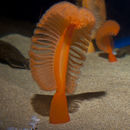en
names in breadcrumbs


The orange sea pen is luminescent. It has no light-producing organs, but its color comes from mucous formed in response to touch. Luminosity is inhibited by exposure to direct light. Sea pens also live symbiotically with Pseudoporcellanella (a crab).
Sea pens have inhabited the earth's surface for hundreds of millions of years. Currently, their numbers are not declining or threatened. Because sea pens are vulnerable to dredges used for oyster harvesting, the only threat to their survival arises from humans. Sea pens are found throughout the world, from tropical to Anarctic waters.
Ptilosarcus gurneyi is a planktonic feeder. The autozooid branch of the polyp filters minute organisms into the main axis of the sea pen. These organisms are digested by fluid secreted from special filaments. The particles are phagocytized and passed to mesogloeal cells, in which the digestion process is completed.
British Columbia to Central California.
Biogeographic Regions: pacific ocean (Native )
Ptilosarcus gurneyi are found anchored in soft or sandy substrates. They live in a range from below the low-tide line to water more than 30 meters (100 ft) deep.
Aquatic Biomes: benthic ; coastal
Sea pens grow to be about 46 cm high and 102 mm wide. They consist of 20 pairs of flat, wide side branches with rows of polyps along both edges.
Other Physical Features: ectothermic ; radial symmetry
Sea pens reproduce by spawning. Typical egg size is 500-600 micrometers. The peak breeding season occurs from March until April. Fertilized ova develop into planula, which are non-feeding and free-swimming and usually settle quickly. Once settled, the planula larva metamorphose into a polyp, and their base becomes a stem. The secondary polyps grow laterally from this structure. The juveniles grow rapidly; they can survive unfed for weeks.
Parental Investment: no parental involvement